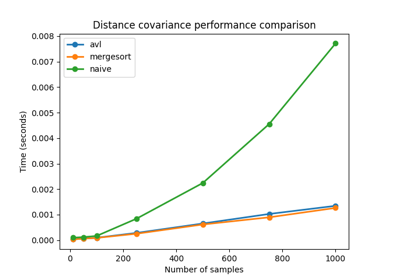rowwise#
- rowwise(function, x, y, *, rowwise_mode=RowwiseMode.AUTO, **kwargs)[source]#
Compute a dependency measure between pairs of elements.
It will use an optimized implementation if one is available.
- Parameters
function (Callable[[...], Array]) – Dependency measure function.
x (Array) – First list of random vectors. The columns of each vector correspond with the individual random variables while the rows are individual instances of the random vector.
y (Array) – Second list of random vectors. The columns of each vector correspond with the individual random variables while the rows are individual instances of the random vector.
rowwise_mode (RowwiseMode) – Mode of rowwise computations.
kwargs (Any) – Additional options necessary.
- Returns
A length \(n\) vector where the \(i\)-th entry is the dependency between \(x[i]\) and \(y[i]\).
- Return type
Array
Examples
>>> import numpy as np >>> import dcor
The following example shows two computations of distance covariance between random variables. This has an optimized implementation using multiple cores if available.
>>> a = [np.array([1., 2., 3., 4., 5. ,6.]), ... np.array([7., 8., 9., 10., 11., 12.]) ... ] >>> b = [np.array([1., 4., 9., 16., 25., 36.]), ... np.array([1., 3., 6., 8., 10., 12.]) ... ] >>> dcor.rowwise(dcor.distance_covariance, a, b) array([3.45652005, 1.95789002])
The following example shows two computations of distance correlation between random vectors of length 2. Currently there is no optimized implementation for the random vector case, so it will be equivalent to calling map.
>>> a = [np.array([[1., 1.], ... [2., 4.], ... [3., 8.], ... [4., 16.]]), ... np.array([[9., 10.], ... [11., 12.], ... [13., 14.], ... [15., 16.]]) ... ] >>> b = [np.array([[0., 1.], ... [3., 1.], ... [6., 2.], ... [9., 3.]]), ... np.array([[5., 1.], ... [8., 1.], ... [13., 1.], ... [21., 1.]]) ... ] >>> dcor.rowwise(dcor.distance_correlation, a, b) array([0.98182263, 0.98320103])
